
There’s no escape from the cruel sea
The anonymous grave of a drowned merchant seaman washed up on Mull provides a timely reminder of just how lethal the Atlantic Ocean can be.
Halfway along a lonely road which passes alongside Loch Spelve on Mull, there is an isolated graveyard. It’s called Balure Cemetery, the name probably derived from the Gaelic word Ball-y-ure meaning ‘the place of the yew’.
There is indeed a huge yew tree overhanging the entrance to the graveyard, possibly several hundred years old, and the other day I stopped to take a closer look.
It is a melancholic and atmospheric place, surrounded by a stone wall with the mountains towering behind. By the gate is a grey granite tombstone which caught my attention. Beneath the ‘MN’ symbol of the Merchant Navy there is a mournful epitaph that reads, ‘A sailor of the 1939-45 war. Merchant Navy. Buried 6th September 1940’.
As I drove home I couldn’t get the sad image of the unknown sailor’s grave out of my mind.
Who knows where he came from – and what a strange place to land up, washed up on the shores of the Isle of Mull. He would have been a victim of the Atlantic war that raged for six years as the German U-boats terrorised the North Atlantic with their submarine ‘wolfpack’ tactics that led to the deaths of some 30,000 sailors.
Seeing the grave recalled my own experiences of the North Atlantic, which, while obviously nothing by comparison, did give me some small insight into the loneliness and mercilessness of that vast ocean.
In 2008 I skippered the sailing boat we were once lucky enough to own from New York up to Halifax and then across the Grand Banks into that utterly, almost unimaginably lonely wilderness of wind and water.
I had one crewman with me, David Pettigrew, and my routine was to keep watch from midnight through to six in the morning, when David would appear with a blessed cup of coffee before taking over the watch.
One morning just after sun-up, a thousand miles from land, I was lost in a reverie, the boat rolling and the sails flapping a little in the light wind. I looked out at the grey water all around me, lifting and falling languorously and showing a little green from time to time.
Then my eyes focused in on what I realised was the rust-coloured body of a large oceanic whitetip, framed for a moment on the side of a rising lump of water.
Like the sea state, the shark seemed to be dawdling, going nowhere in particular. But then it saw us, and in a second became all purpose. It shot over towards the boat, thrashing the water with its tail, clearly very excited at the sight of this alien object that had appeared in its watery world. It circled the boat twice and then dropped off, disappointed to have found nothing, and let us cruise away slowly.

The treacherous North Atlantic
That wasn’t the only moment of danger we faced on the trip across the Atlantic. Several hundred miles out of the Nova Scotia port of Halifax, and far from help, we were hit by the tail end of Hurricane Bertha.
For three days and nights we battled the storm, with the hurricane force winds whipping up massive seas, the waves reaching over thirty metres. I had never sailed in or even seen such conditions, and the experience was truly terrifying. Eventually, after three days, we gave up fighting and ‘hove to’, letting the boat do the job she was built for and ride out the storm with just a minimal amount of sail set to keep her steady.
I’ve never been as happy as I was when we finally reached Crosshaven on the southern coast of Ireland; that first pint of Guinness was an unforgettable experience. And I’m so glad Juliet decided the day before we left New York that she and our two boys wouldn’t, after all, join me on that transatlantic sailing.
It all felt so very lonely and lethal. We were beyond air rescue in a place that had once been a war zone, where – in these exact latitudes – ships were once given strict orders not to stop for the rafts of survivors from torpedoed ships.
I cannot think of a lonelier or more frightening place for people to find themselves without the protection of a good ship. And it was there, in the midst of all that nothingness, that the wolf packs waited, torpedoing the merchant ships at night then diving down to avoid detection after the murder was done. Those lonely reaches, so remote and lethal, were referred to by the sailors of the day as the ‘black pit’.
As all those who have crossed the North Atlantic will know, wind and current are all set in an easterly direction, so it only stands to reason that at times the western facing islands of Scotland and their windward coasts would have provided islanders with some truly tragic finds. Who was that man found washed up on Mull in 1940?
I have heard that there are 12 other such unnamed graves on Mull, mainly around the south-western ends of the island, the Ross of Mull and Iona. I have now made it a mission to set out to find every one of these graves, and pay a small personal tribute to these men who had not just their lives but also their very identities stolen by the sea.
As someone who makes his living on the water, I have a particular sympathy and fear of such a death, in the malevolent North Atlantic.
(This feature was originally published in 2016)
TAGS

